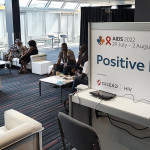The experimental integrase inhibitor S/GSK1349572 (S/GSK-572) reduced viral load to undetectable levels in 96 percent of first-time HIV treatment takers receiving 10 milligrams (mg) of the drug in a clinical trial, compared with 60 percent of those receiving standard doses of Sustiva (efavirenz), according to preliminary 16-week data reported Friday, July 22, at the XVIII International AIDS Conference in Vienna.
S/GSK-572 is a once-daily integrase inhibitor, without the need for low-dose Norvir (ritonavir) boosting, being developed by Shionogi Pharmaceuticals and ViiV Healthcare. The drug shows promise for people with HIV harboring some resistance mutations to first-generation integrase inhibitor Isentress (raltegravir), according to another preliminary study presented in Vienna. S/GSK-572 was also found to be highly active in an 11-day study reported last summer.
Early data from the SPRING-1 study, involving 205 treatment-naive patients, were reported by Garrett Nichols, MD, of GlaxoSmithKline and his colleagues. The study, which will last 96 weeks, is comparing three doses of S/GSK-572—10 mg, 25 mg or 50 mg, taken once a day—with Sustiva, all combined with either Truvada (tenofovir plus emtricitabine) or Epzicom (abacavir plus lamivudine).
Eighty-six percent of the study participants are male, and 20 percent are people of color. Twenty-one percent entered the study with viral loads above 100,000 copies.
More than 90 percent of study volunteers in all S/GSK-572 dosing groups combined, compared with 60 percent of those allotted to take Sustiva, had viral loads below 50 copies—undetectable—after 16 weeks. In the individual S/GSK-572 dosing groups, 96 percent of those taking 10 mg of the drug had an undetectable viral load after 16 weeks, compared with 92 and 90 percent of those receiving 25 mg and 50 mg of the drug, respectively. The study was not, however, powered sufficiently to render statistical comparisons between the groups, thus it is not clear if this difference was due to chance.
Patients’ viral loads upon entering the study averaged 32,000 copies. After 16 weeks, viral loads were 2.39 log lower in the 10 mg group, 2.37 log lower in the 25 mg group and 2.40 log lower in the 50 mg group, compared with 1.93 log lower in the Sustiva group.
Time to virologic suppression was significantly shorter for subjects treated with S/GSK-572 compared with those receiving Sustiva. According to Nichols, 66 percent of patients treated with S/GSK-572 had undetectable viral loads after four weeks of treatment, compared with only 18 percent of those in the Sustiva group.
Nichols reported that two virologic failures have occurred in the study thus far—one among those taking S/GSK-572, and one in the Sustiva group. He noted, however, that the S/GSK-572 patient who experienced virologic failure has no signs of resistance to the integrase inhibitor.
CD4s increased, on average, 165 cells in the combined S/GSK-572 groups, compared with 116 cells in the Sustiva group.
As for side effects, S/GSK-572 appears well tolerated thus far. Moderate-to-severe side effects, after 16 weeks of treatment, were documented in 18 percent of those in the Sustiva group compared with 6 percent of those receiving S/GSK-572.
Gastrointestinal side effects—nausea and diarrhea—were the only moderate-to-severe adverse events to occur in more than one patient in the combined S/GSK-572 groups. Moderate-to-severe nausea and diarrhea occurred in 4 percent of those in the Sustiva group, compared with 2 percent in the combined S/GSK-572 groups. Adverse events occurring in more than one Sustiva patient included psychiatric problems (documented in 6 percent) and rash (4 percent).
Moderate-to-severe lab abnormalities were rare in both groups, occuring in 7 percent of those in the S/GSK-572 groups and 10 percent of those in the Sustiva group. However, changes in lipids were reported by Nichols as being more favorable in the S/GSK-572 group; “bad” LDL cholesterol levels increased more in the Sustiva group.
As summarized by Nichols, S/GSK-572 administered once-daily is proving well tolerated, with potent antiviral activity, at all doses in this study involving treatment-naive patients. These data, he said, fully support the ViiV’s decision to move forward with Phase III development of the drug, which was announced Wednesday, July 22, by the company.






Comments
Comments